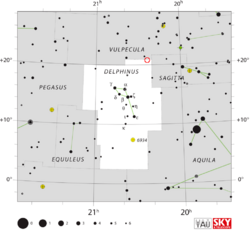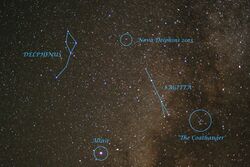Astronomy:V339 Delphini
| Observation data Equinox J2000.0]] (ICRS) | |
|---|---|
| Constellation | Delphinus |
| Right ascension | 20h 23m 30.6865s[1] |
| Declination | +20° 46′ 03.7774″[1] |
| Apparent magnitude (V) | 4.5 Max. 17.5 Min.[2] |
| Characteristics | |
| Variable type | Nova[2] |
| Astrometry | |
| Proper motion (μ) | RA: −4.140±0.534[1] mas/yr Dec.: −8.609±0.513[1] mas/yr |
| Parallax (π) | 0.3814 ± 0.3615[1] mas |
| Distance | 2130+2250 −400[2] pc |
| Other designations | |
| Database references | |
| SIMBAD | data |

V339 Delphini or Nova Delphini 2013 (PNV J20233073+2046041) is a bright nova star in the constellation Delphinus. It was discovered on 14 August 2013 by amateur astronomer Koichi Itagaki in Japan and confirmed by the Liverpool Telescope on La Palma. The nova appeared with a magnitude 6.8 when it was discovered and peaked at magnitude 4.3 on 16 August 2013.[4][5][6] A nova is produced by the fusion of accumulated material on the white dwarf nova progenitor acquired from its companion star. The nova system is thus a binary star, and a classical nova.[7] The white dwarf is a carbon-oxygen white dwarf,[8] with an estimated mass of 1.04±0.02 M☉.[9] There is not yet a consensus about what the binay's orbital period is; estimates range from 3.15 hours[10] to 6.43 hours.[9]

V339 Del is the first nova that has been observed to synthesize the element lithium. Production of lithium-7 from the decay of beryllium-7, which was observed in the wind blown out of the nova. This is the first direct evidence of the supply of lithium to the interstellar medium by an astronomical object. Lithium-7 is fragile in the environment at the center of a nova, so being blown out of the environment at the center is necessary for the observation of lithium. The beryllium was produced by the fusion of helium-3 with helium-4. Nucleosynthesis of lithium is important in the study of chemical abundances in the universe.[7]
See also
- List of novae in the Milky Way galaxy
- Nova Centauri 2013
References
- ↑ 1.0 1.1 1.2 1.3 1.4 Brown, A. G. A. (August 2018). "Gaia Data Release 2: Summary of the contents and survey properties". Astronomy & Astrophysics 616: A1. doi:10.1051/0004-6361/201833051. Bibcode: 2018A&A...616A...1G. Gaia DR2 record for this source at VizieR.
- ↑ 2.0 2.1 2.2 Schaefer, Bradley E. (2018). "The distances to Novae as seen by Gaia". Monthly Notices of the Royal Astronomical Society 481 (3): 3033–3051. doi:10.1093/mnras/sty2388. Bibcode: 2018MNRAS.481.3033S.
- ↑ "V339 Delphini". SIMBAD. Centre de données astronomiques de Strasbourg. http://simbad.u-strasbg.fr/simbad/sim-basic?Ident=V339+Delphini.
- ↑ "Light Curve Generator: AAVSO Data for Nova DEL 2013". American Association of Variable Star Observers. 16 August 2013. http://www.aavso.org/lcg/plot?auid=000-BLC-933&starname=NOVA%20DEL%202013&lastdays=30&start=2456518.157746227&stop=2456528.157746227&obscode=&obscode_symbol=2&obstotals=yes&calendar=calendar&forcetics=&grid=on&visual=on&r=on&bband=on&v=on&pointsize=1&width=800&height=450&mag1=&mag2=&mean=&vmean=.
- ↑ Bob King (14 August 2013). "Bright New Nova In Delphinus — You can See it Tonight With Binoculars". Universe Today. http://www.universetoday.com/104103/bright-new-nova-in-delphinus-you-can-see-it-tonight-with-binoculars/#more-104103.
- ↑ Robin Burks (27 October 2014). "Astronomers observe exploding fireball stage of nova". Tech Times. http://www.techtimes.com/articles/18825/20141027/astronomers-observe-exploding-fireball-stage-of-nova.htm.
- ↑ 7.0 7.1 "Classical nova explosions are major lithium factories in the universe". Science Daily. 19 February 2015. https://www.sciencedaily.com/releases/2015/02/150219085831.htm.
- ↑ DeGennaroAquino, I.; Schroder, K.P.; Mittag, M.; Wolter, U.; Jack, D.; Eenens, P.; Gonzalez-Perez, J.N.; Hempelmann, A. et al. (September 2015). "High spectral resolution monitoring of Nova V339 Delphini with TIGRE". Astronomy & Astrophysics 581: A134. doi:10.1051/0004-6361/201525810. Bibcode: 2015A&A...581A.134D. https://www.aanda.org/articles/aa/full_html/2015/09/aa25810-15/aa25810-15.html. Retrieved 9 December 2020.
- ↑ 9.0 9.1 Chochol, D.; Shugarov, S.; Pribulla, T.; Volkov, I. (March 2014). "Photometry and spectroscopy of the classical nova V339 Del (Nova Del 2013) in the first month after outburst". Contributions of the Astronomical Observatory Skalnaté Pleso 43 (3): 330–337. Bibcode: 2014CoSka..43..330C. http://articles.adsabs.harvard.edu/pdf/2014CoSka..43..330C. Retrieved 10 December 2020.
- ↑ Chochol, D.; Ikonnikova, N.; Katysheva, N.; Shugarov, S.; Volkov, I. (2015). "Multicolor Photometry of the Novae V339 Del and V2659 Cyg". Living Together: Planets, Host Stars, and Binaries ASP Conference Series 496: 237–239. Bibcode: 2015ASPC..496..237C. http://www.aspbooks.org/publications/496/237.pdf. Retrieved 10 December 2020.
- Central Bureau for Astronomical Telegrams, PNV J20233073+2046041 Transient Object Followup Reports
Further reading
- Akito Tajitsu; Kozo Sadakane; Hiroyuki Naito; Akir Arai et al. (19 February 2015). "Explosive lithium production in the classical nova V339 Del (Nova Delphini 2013)". Nature 518 (7539): 381–384. 18 February 2015. doi:10.1038/nature14161. PMID 25693569. Bibcode: 2015Natur.518..381T.
External links
- Sky and Telescope, Bright Nova in Delphinus
- FastSWF, Nova Delphini Evolution 2013-2014 - Animation (hgg)
Coordinates: ![]() 20h 23m 30.68s, +20° 46′ 3.7″
20h 23m 30.68s, +20° 46′ 3.7″
 |





